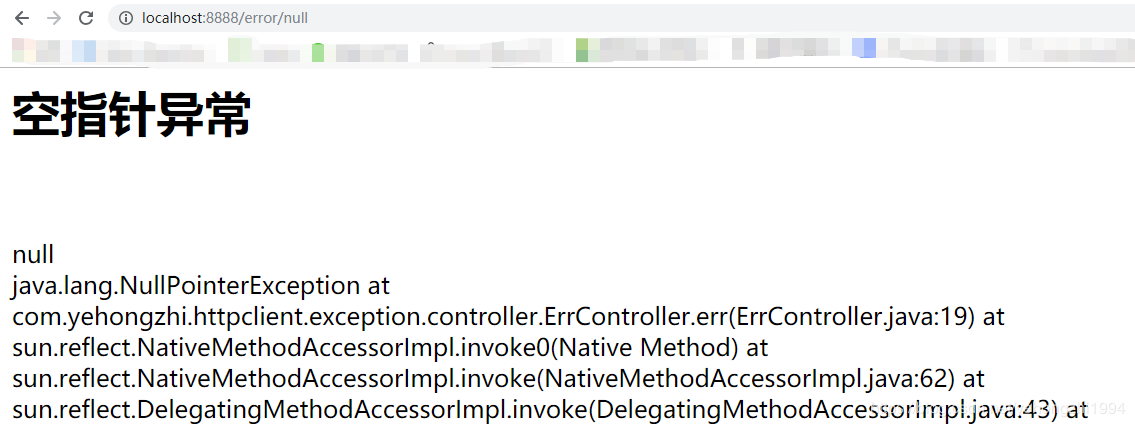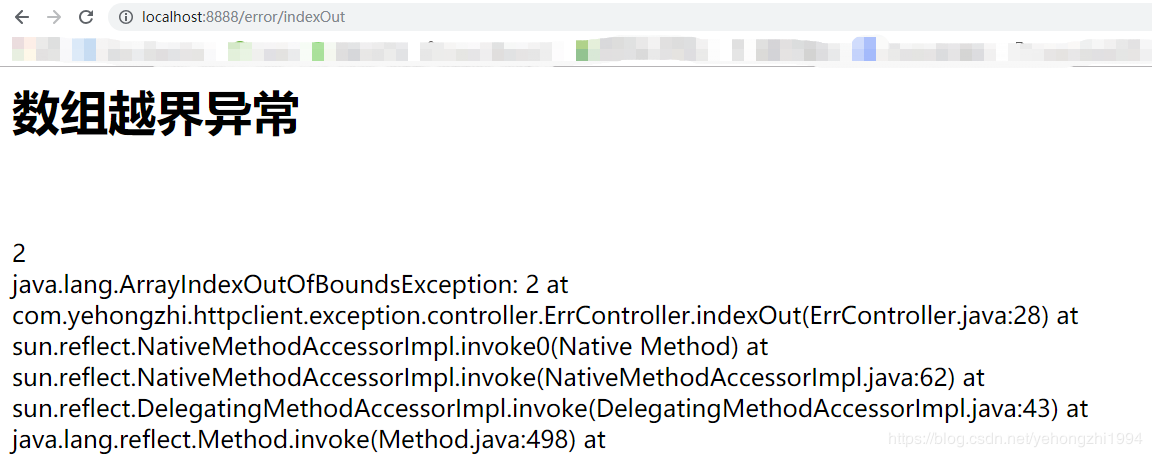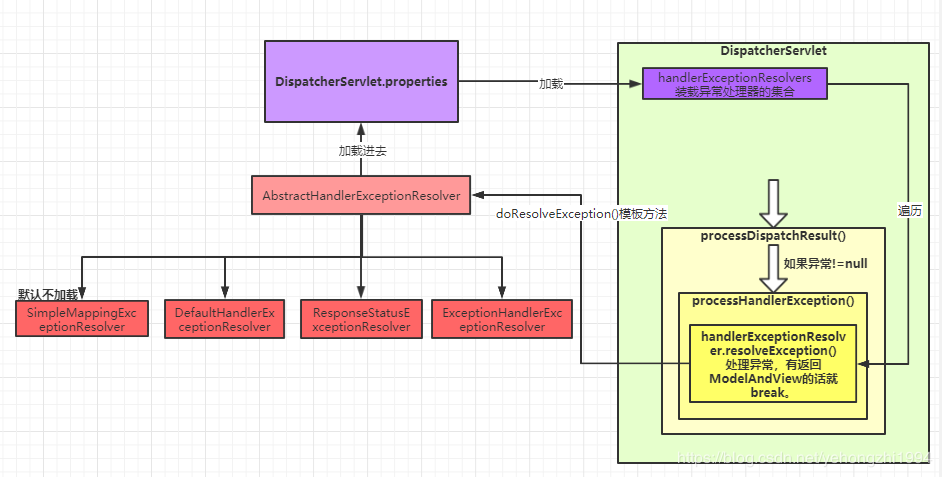SpringMVC全局异常处理
SpringMVC除了可以做URL映射和请求拦截外,还可以做全局异常的处理。全局异常处理可能我们平时比较少机会接触,但是每个项目都肯定会做这个处理。比如在上一间公司,是前后端分离的架构,所以后端只要有运行时异常就会报“系统异常,请稍后再试”。如果想要走上架构师的话,这个肯定是要学会的。
SpringMVC全局异常处理机制
首先,要知道全局异常处理,SpringMVC提供了两种方式:
- 实现
HandlerExceptionResolver接口,自定义异常处理器。 - 使用
HandlerExceptionResolver接口的子类,也就是SpringMVC提供的异常处理器。
所以,总得来说就两种方式,一种是自定义异常处理器,第二种是SpringMVC提供的。接下来先说SpringMVC提供的几种异常处理器的使用方式,然后再讲自定义异常处理器。
SpringMVC提供的异常处理器有哪些呢?我们可以直接看源码的类图。

DefaultHandlerExceptionResolver,默认的异常处理器。根据各个不同类型的异常,返回不同的异常视图。SimpleMappingExceptionResolver,简单映射异常处理器。通过配置异常类和view的关系来解析异常。ResponseStatusExceptionResolver,状态码异常处理器。解析带有@ResponseStatus注释类型的异常。ExceptionHandlerExceptionResolver,注解形式的异常处理器。对@ExceptionHandler注解的方法进行异常解析。
DefaultHandlerExceptionResolver
这个异常处理器是SprngMVC默认的一个处理器,处理一些常见的异常,比如:没有找到请求参数,参数类型转换异常,请求方式不支持等等。
接着我们看DefaultHandlerExceptionResolver类的doResolveException()方法:
@Override
@Nullable
protected ModelAndView doResolveException(HttpServletRequest request, HttpServletResponse response,@Nullable Object handler, Exception ex) {
try {
if (ex instanceof HttpRequestMethodNotSupportedException) {
return handleHttpRequestMethodNotSupported((HttpRequestMethodNotSupportedException) ex, request,
response, handler);
}
else if (ex instanceof HttpMediaTypeNotSupportedException) {
return handleHttpMediaTypeNotSupported((HttpMediaTypeNotSupportedException) ex, request, response,
handler);
}
else if (ex instanceof HttpMediaTypeNotAcceptableException) {
return handleHttpMediaTypeNotAcceptable((HttpMediaTypeNotAcceptableException) ex, request, response,
handler);
}
//省略...以下还有十几种异常的else-if
}catch (Exception handlerException) {
//是否打开日志,如果打开,那就记录日志
if (logger.isWarnEnabled()) {
logger.warn("Handling of [" + ex.getClass().getName() + "] resulted in Exception", handlerException);
}
}
return null;
}
通过if-else判断,判断继承什么异常就显示对应的错误码和错误提示信息。由此可以知道,处理一般有两步,一是设置响应码,二是在响应头设置异常信息。下面是MissingServletRequestPartException的处理的源码:
protected ModelAndView handleMissingServletRequestPartException(MissingServletRequestPartException ex,
HttpServletRequest request, HttpServletResponse response, @Nullable Object handler) throws IOException {
//设置响应码,设置异常信息,SC_BAD_REQUEST就是400(bad request)
response.sendError(HttpServletResponse.SC_BAD_REQUEST, ex.getMessage());
return new ModelAndView();
}
//响应码
public static final int SC_BAD_REQUEST = 400;
为什么要存在这个异常处理器呢?
从框架的设计理念来看,这种公共的、常见的异常应该交给框架本身来完成,是一些必需处理的异常。比如参数类型转换异常,如果程序员不处理,还有框架提供默认的处理方式,不至于出现这种错误而无法排查。
SimpleMappingExceptionResolver
这种异常处理器需要提前配置异常类和对应的view视图。一般用于使用JSP的项目中,出现异常则通过这个异常处理器跳转到指定的页面。
怎么配置?首先搭建JSP项目我就不浪费篇幅介绍了。首先要加载一个XML文件。
@SpringBootApplication
//在启动类,加载配置文件
@ImportResource("classpath:spring-config.xml")
public class Application {
public static void main(String[] args) {
SpringApplication.run(Application.class, args);
}
}
然后在resources目录下,创建一个spring-config.xml文件,内容如下:
<?xml version="1.0" encoding="UTF-8"?>
<beans xmlns="http://www.springframework.org/schema/beans"
xmlns:xsi="http://www.w3.org/2001/XMLSchema-instance"
xsi:schemaLocation="http://www.springframework.org/schema/beans http://www.springframework.org/schema/beans/spring-beans.xsd">
<bean class="org.springframework.web.servlet.handler.SimpleMappingExceptionResolver">
<!-- 定义默认的异常处理页面 -->
<property name="defaultErrorView" value="err"/>
<!-- 定义异常处理页面用来获取异常信息的变量名,默认名为exception -->
<property name="exceptionAttribute" value="ex"/>
<!-- 定义需要特殊处理的异常,用类名或完全路径名作为key,异常也页名作为值 -->
<property name="exceptionMappings">
<props>
<!-- 数组越界异常 -->
<prop key="java.lang.ArrayIndexOutOfBoundsException">err/arrayIndexOutOfBounds</prop>
<!-- 空指针异常 -->
<prop key="java.lang.NullPointerException">err/nullPointer</prop>
</props>
</property>
</bean>
</beans>
然后在webapp也就是存放JSP页面的目录下,创建两个JSP页面。
arrayIndexOutOfBounds.jsp如下:
<%@ page contentType="text/html;charset=UTF-8" language="java" %>
<html>
<head>
<title>数组越界异常</title>
</head>
<body>
<h1>数组越界异常</h1>
<br>
<%-- 打印异常到页面上 --%>
<% Exception ex = (Exception)request.getAttribute("ex"); %>
<br>
<div><%= ex.getMessage() %></div>
<% ex.printStackTrace(new java.io.PrintWriter(out)); %>
</body>
</html>
nullPointer.jsp如下:
<%@ page contentType="text/html;charset=UTF-8" language="java" %>
<html>
<head>
<title>空指针异常</title>
</head>
<body>
<h1>空指针异常</h1>
<br>
<%-- 打印异常到页面上 --%>
<% Exception ex = (Exception)request.getAttribute("ex"); %>
<br>
<div><%=ex.getMessage()%></div>
<% ex.printStackTrace(new java.io.PrintWriter(out)); %>
</body>
</html>
接着创建两个Controller,分别抛出空指针异常和数组越界异常。
@Controller
@RequestMapping("/error")
public class ErrController {
@RequestMapping("/null")
public String err() throws Exception{
String str = null;
//抛出空指针异常
int length = str.length();
System.out.println(length);
return "index";
}
@RequestMapping("/indexOut")
public String indexOut() throws Exception{
int[] nums = new int[2];
for (int i = 0; i < 3; i++) {
//抛出数组越界异常
nums[i] = i;
System.out.println(nums[i]);
}
return "index";
}
}
启动项目后,我们发送两个请求,就可以看到:


ResponseStatusExceptionResolver
这种异常处理器主要用于处理带有@ResponseStatus注释的异常。下面演示一下使用方式。
首先自定义异常类继承Exception,并且使用@ResponseStatus注解修饰。如下:
//value需要使用HttpStatus枚举类型,HttpStatus.FORBIDDEN=403。
@ResponseStatus(value = HttpStatus.FORBIDDEN,reason = "My defined Exception")
public class DefinedException extends Exception{
}
然后再在Controller层抛出此异常。如下:
@Controller
@RequestMapping("/error")
public class ErrController {
@RequestMapping("/myException")
public String ex(@RequestParam(name = "num") Integer num) throws Exception {
if (num == 1) {
//抛出自定义异常
throw new DefinedException();
}
return "index";
}
}
然后启动项目,请求接口,可以看到如下信息:

service或者dao层就try-catch处理掉的话,是不会触发的。
ExceptionHandlerExceptionResolver
这个异常处理器才是最重要的,也是最常用,最灵活的,因为是使用注解。首先我们还是简单地演示一下怎么使用:
首先需要定义一个全局的异常处理器。
//这里使用了RestControllerAdvice,是@ResponseBody和@ControllerAdvice的结合
//会把实体类转成JSON格式的提示返回,符合前后端分离的架构
@RestControllerAdvice
public class GlobalExceptionHandler {
//这里自定义了一个BaseException,当抛出BaseException异常就会被此方法处理
@ExceptionHandler(BaseException.class)
public ErrorInfo errorHandler(HttpServletRequest req, BaseException e) throws Exception {
ErrorInfo r = new ErrorInfo();
r.setMessage(e.getMessage());
r.setCode(ErrorInfo.ERROR);
r.setUrl(req.getRequestURL().toString());
return r;
}
}
然后我们自定义一个自定义异常类BaseException:
public class BaseException extends Exception {
public BaseException(String message) {
super(message);
}
}
然后在Controller层定义一个方法测试:
@Controller
@RequestMapping("/error")
public class ErrController {
@RequestMapping("/base")
public String base() throws BaseException {
throw new BaseException("系统异常,请稍后重试。");
}
}
老规矩,启动项目,请求接口可以看到结果:

BaseException,而直接拦截常见的各种异常都可以。所以这是一个非常灵活的异常处理器。你也可以做跳转页面,返回ModelAndView即可(以免篇幅过长就不演示了,哈哈)。
小结
经过以上的演示后我们学习了SpringMVC四种异常处理器的工作机制,最后这种作为程序员我觉得是必须掌握的,前面的简单映射异常处理器和状态映射处理器可以选择性掌握,默认的异常处理器了解即可。
那这么多异常处理器,究竟是如何工作的呢?为什么是设计一个接口,下面有一个抽象类加上四个实现子类呢?接下来我们通过源码分析来揭开谜底!
源码分析
源码分析从哪里入手呢?在SpringMVC中,其实你想都不用想,肯定在DispatcherServlet类里。经过我顺藤摸瓜,我定位在了processHandlerException()方法。怎么定位的呢?其实很简单,看源码:
private void processDispatchResult(HttpServletRequest request, HttpServletResponse response,
@Nullable HandlerExecutionChain mappedHandler, @Nullable ModelAndView mv,
@Nullable Exception exception) throws Exception {
boolean errorView = false;
//异常不为空
if (exception != null) {
if (exception instanceof ModelAndViewDefiningException) {
logger.debug("ModelAndViewDefiningException encountered", exception);
mv = ((ModelAndViewDefiningException) exception).getModelAndView();
}
else {
Object handler = (mappedHandler != null ? mappedHandler.getHandler() : null);
//关键点:执行异常处理
mv = processHandlerException(request, response, handler, exception);
//省略...
}
}
//省略...
}
processHandlerException()
就是这个直接的一个if-else判断,那个processHandlerException()方法又是怎么处理的呢?
@Nullable
protected ModelAndView processHandlerException(HttpServletRequest request, HttpServletResponse response,
@Nullable Object handler, Exception ex) throws Exception {
ModelAndView exMv = null;
//判断异常处理器的集合是否为空
if (this.handlerExceptionResolvers != null) {
//不为空则遍历异常处理器
for (HandlerExceptionResolver handlerExceptionResolver : this.handlerExceptionResolvers) {
//调用异常处理器的resolveException()方法进行处理异常
exMv = handlerExceptionResolver.resolveException(request, response, handler, ex);
//判断返回的ModelAndView是否为null,不为null则跳出循环,为null则继续下一个异常处理器
if (exMv != null) {
break;
}
}
}
//如果ModelAndView不为空
if (exMv != null) {
if (exMv.isEmpty()) {
//设置异常信息提示
request.setAttribute(EXCEPTION_ATTRIBUTE, ex);
return null;
}
//如果返回的ModelAndView不包含view
if (!exMv.hasView()) {
//设置一个默认的视图
String defaultViewName = getDefaultViewName(request);
if (defaultViewName != null) {
exMv.setViewName(defaultViewName);
}
}
//省略...
//返回异常的ModelAndView
return exMv;
}
throw ex;
}
这不就是责任链模式吗!提前加载异常处理器到handlerExceptionResolvers集合中,然后遍历去执行,能处理就处理,不能处理就跳到下一个异常处理器处理。如果对责任链模式有疑问的,可以看《责任链模式与SpringMVC》。
那接下来我们就有一个问题了,handlerExceptionResolvers集合是怎么加载异常处理器的?这个问题很简单,就是使用DispatcherServlet.properties配置文件。这个文件真的很重要!!!
org.springframework.web.servlet.HandlerExceptionResolver=org.springframework.web.servlet.mvc.method.annotation.ExceptionHandlerExceptionResolver,\
org.springframework.web.servlet.mvc.annotation.ResponseStatusExceptionResolver,\
org.springframework.web.servlet.mvc.support.DefaultHandlerExceptionResolver
默认是加载以上三种异常处理器到集合中,所以只要带有@ControllerAdvice、@ExceptionHandler、@ResponseStatus注解的都会被扫描。SimpleMappingExceptionResolver则是通过xml文件(当然也可以使用@Configuration)去配置。
resolveException()
其实在resolveException()处理异常的方法中,还使用了模板模式。
@Override
@Nullable
public ModelAndView resolveException(HttpServletRequest request, HttpServletResponse response,
@Nullable Object handler, Exception ex) {
//省略...
//预处理
prepareResponse(ex, response);
//调用了一个抽象方法,抽象方法由子类去实现
ModelAndView result = doResolveException(request, response, handler, ex);
//省略...
}
抽象方法doResolveException(),由子类实现。
@Nullable
protected abstract ModelAndView doResolveException(HttpServletRequest request,
HttpServletResponse response, @Nullable Object handler, Exception ex);
怎么识别模板方法,其实很简单,只要看到抽象类,有个具体方法里面调用了抽象方法,那很大可能就是模板模式。抽象方法就是模板方法,由子类实现。
子类我们都知道就是那四个异常处理器实现类了。
总结
用流程图概括一下:

HandlerExceptionResolver接口来实现异常处理器。
实现HandlerExceptionResolver接口实现全局异常处理
首先自定一个异常类MyException。
public class MyException extends Exception {
public MyException(String message) {
super(message);
}
}
然后实现HandlerExceptionResolver接口定义一个异常处理器。
//注册异常处理器到Spring容器中
@Component
public class MyExceptionHandler implements HandlerExceptionResolver {
@Override
public ModelAndView resolveException(HttpServletRequest request, HttpServletResponse response, Object handler, Exception ex) {
try {
//如果属于MyException异常,则输出异常提示到页面
if (ex instanceof MyException) {
response.setContentType("text/html;charset=utf-8");
response.getWriter().println(ex.getMessage());
//这里返回null,不做处理。也可以返回ModelAndView跳转页面
return null;
}
} catch (IOException e) {
e.printStackTrace();
}
return null;
}
}
然后在Controller层定义一个方法测试:
@Controller
@RequestMapping("/error")
public class ErrController {
@RequestMapping("/myEx")
public String myEx() throws MyException {
System.out.println("执行myEx()");
throw new MyException("自定义异常提示信息");
}
}
启动项目,请求接口,我们可以看到:

最后说几句
以上就是我对于SpringMVC全局异常处理机制的理解。更多的java技术分享,可以关注我的公众号,后续会不断更新。
创作不易,不要白票。素质三连,是对我最大的创作动力!有什么疑问可以在评论区留言,非常需要大家的反馈。大佬,你说句话呀!
